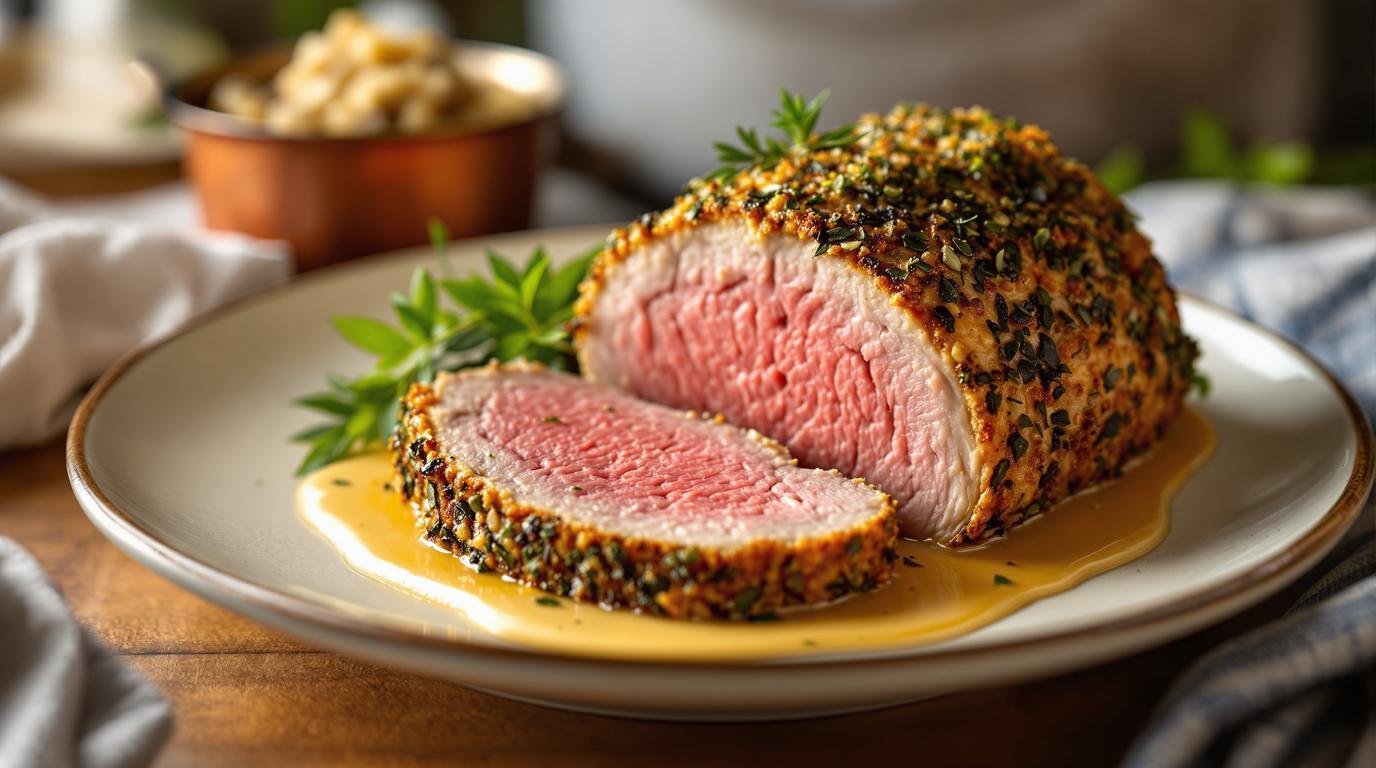There’s something utterly magical about a perfectly roasted veal loin. The first time I prepared Rôti de Veau aux Herbes in a small kitchen in Burgundy, I was struck by how something so seemingly simple could deliver such profound flavor. This traditional French herb-crusted veal roast isn’t just dinner – it’s a sensory experience where buttery-soft meat meets aromatic herbs in perfect harmony. What surprised me most was discovering that the 15-minute resting period might be the most crucial step in the entire process!
The Story
Rôti de Veau aux Herbes isn’t just another roast – it’s the cornerstone of French Sunday family dinners. While working in a bistro outside Lyon, I watched the head chef prepare this dish with such reverence that it forever changed my approach to roasting. The secret lies in its deceptive simplicity: quality veal, fresh herbs, and patience. This isn’t cooking that shouts; it whispers with elegance and restraint. What makes this recipe special is how the herb crust creates a protective layer that gently perfumes the meat while keeping it succulent.
Ingredients Spotlight
• 3 lb (1.5 kg) veal loin or leg roast
• 2 tbsp (30 ml) olive oil
• 3 cloves garlic, minced
• 1 bunch fresh tarragon (about ½ cup chopped)
• ½ cup (15g) fresh parsley, finely chopped
• 3 sprigs fresh thyme, leaves removed
• 1 tsp (5g) sea salt
• 1 tsp (5g) freshly ground black pepper
• 1 bay leaf
• ¾ cup (200 ml) dry white wine
• 1½ cups (400 ml) veal or chicken stock
• 3 tbsp (50 ml) heavy cream (optional)
The star here is undoubtedly fresh tarragon – its distinctive anise-like flavor is what separates an ordinary roast from something truly memorable. When selecting your veal, look for pale pink meat with a small amount of milky-white fat. The quality of your herbs matters tremendously; this is not the time for dried substitutes.
Step-by-Step Guide
1. Remove the veal from refrigeration 30 minutes before cooking to allow it to come to room temperature.
2. Preheat your oven to 350°F (180°C).
3. Create your herb paste by combining chopped tarragon, parsley, thyme, minced garlic, 1 tablespoon olive oil, salt, and pepper.
4. Thoroughly pat the veal dry with paper towels, then massage the herb mixture all over the meat, pressing gently to adhere.
5. Heat the remaining tablespoon of oil in a large, oven-safe Dutch oven or cocotte over medium-high heat.
6. Sear the veal on all sides until golden brown, about 2 minutes per side.
7. Remove the roast, add a layer of chopped onions and carrots if desired, then place the veal on top.
8. Add the bay leaf and stock to the pan, cover with a lid.
9. Roast for approximately 75 minutes, or until an instant-read thermometer registers 155°F (68°C) for medium doneness.
10. Transfer the veal to a cutting board and let rest for 15 minutes under loose foil.
11. Meanwhile, place the Dutch oven on the stovetop over medium heat, add wine, and deglaze the pan, scraping up all the flavorful browned bits.
12. Simmer until reduced by half, then whisk in cream if using, and cook until slightly thickened.
13. Slice the veal against the grain and serve with the herb-infused sauce.
Expert Techniques
The difference between a good roast and a remarkable one often comes down to technique. First, don’t rush the searing process – those caramelized flavors are the foundation of your dish. Second, consider using a digital probe thermometer that stays in the meat while roasting; veal can go from perfect to overcooked in minutes. Lastly, the deglazing step isn’t optional – those browned bits (fond) contain concentrated flavor compounds that transform your sauce.
Chef’s Note: When I was cooking at a small restaurant in Paris, we’d make small incisions in the veal and insert slivers of garlic throughout the roast. This creates pockets of intense flavor that bloom during roasting. Try this variation if you’re particularly fond of garlic.
Presentation & Pairing Ideas
Slice the veal thinly against the grain and arrange it in a slightly overlapping pattern on warmed plates. Drizzle with sauce rather than flooding the plate – this isn’t the place for a sauce bath. A traditional Beef Bourguignon approach to presentation works beautifully here. For sides, I recommend either crisp mushroom risotto or simple roasted potatoes with rosemary.
Wine-wise, opt for a crisp white like Sancerre or Chablis – their acidity cuts through the richness while complementing the herbs. If red is your preference, choose a light-bodied Pinot Noir. For a complete seasonal menu, consider starting with a delicate salad and finishing with a raspberry sorbet to cleanse the palate.
Make this recipe truly yours by experimenting with your own herb combinations. While tarragon is traditional, I’ve created stunning variations using sage and rosemary in fall, or basil and mint in summer. The beauty of this dish lies in its adaptability – master the technique, then let your creativity and the seasons guide your personal interpretation. Remember, recipes are road maps, not rulebooks!
